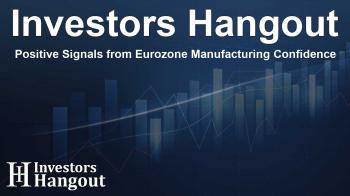Positive Signals from Eurozone Manufacturing Confidence

Positive Signals in Eurozone Manufacturing Confidence
The recent increase in the composite PMI from 50.9 to 51.1 suggests that the eurozone economy is holding strong amidst global challenges. Improvements in new orders and increased hiring indicate a potential acceleration of growth, even though significant risks still loom on the horizon.
Manufacturing Output Shows Remarkable Growth
Eurozone manufacturing has experienced fluctuations, particularly in response to global factors like tariffs. After a steep decline in production in June, the manufacturing output PMI rebounded impressively, rising from 50.6 to 52.3, marking its highest level in over three years.
Services Sector Remains Cautious
While manufacturing data reflects a positive trend, the service sector has not followed suit. The services PMI slipped slightly from 51 to 50.7, indicating that domestic demand is still lacking. Consumer spending remains cautious, and businesses are hesitant, reflecting uncertainty about the economy's direction.
Encouraging Signs for Future Growth
Despite these mixed signals, there are encouraging developments in both manufacturing and services. An improvement in new orders and a rise in hiring, especially in the service sector, provide optimism in an economy that has struggled for an extended period.
Impact of Trade Relations on Economic Outlook
The PMI outcomes suggest that the economy is not overly affected by ongoing trade tensions at this moment. With a potential easing in trade uncertainty following recent agreements, we could witness further economic growth, although several risks remain that could impede this progress.
Conclusion
In summary, the PMI presents a hopeful image of the Eurozone's economic landscape, with signs of recovery in manufacturing and a cautious wait-and-see approach in services. As the situation evolves, it will be crucial to monitor these trends and their implications for future growth.
Frequently Asked Questions
What does the recent PMI data indicate about the Eurozone economy?
The recent PMI data indicates that the Eurozone economy is showing signs of growth, particularly in manufacturing, despite underlying risks.
How has the manufacturing output PMI changed recently?
The manufacturing output PMI rose significantly from 50.6 to 52.3, marking the highest reading in over three years.
What challenges does the service sector currently face?
The service sector's PMI declined slightly, indicating sluggish domestic demand and uncertainty among consumers and businesses.
Are there signs of hiring growth in the Eurozone?
Yes, there has been an increase in hiring within the service sector, which suggests positive trends in employment.
What are the potential risks to the Eurozone's economic outlook?
Despite positive indicators, significant risks remain due to global trade uncertainties and domestic economic conditions that could affect growth.
About The Author
Contact Olivia Taylor privately here. Or send an email with ATTN: Olivia Taylor as the subject to contact@investorshangout.com.
About Investors Hangout
Investors Hangout is a leading online stock forum for financial discussion and learning, offering a wide range of free tools and resources. It draws in traders of all levels, who exchange market knowledge, investigate trading tactics, and keep an eye on industry developments in real time. Featuring financial articles, stock message boards, quotes, charts, company profiles, and live news updates. Through cooperative learning and a wealth of informational resources, it helps users from novices creating their first portfolios to experts honing their techniques. Join Investors Hangout today: https://investorshangout.com/
The content of this article is based on factual, publicly available information and does not represent legal, financial, or investment advice. Investors Hangout does not offer financial advice, and the author is not a licensed financial advisor. Consult a qualified advisor before making any financial or investment decisions based on this article. This article should not be considered advice to purchase, sell, or hold any securities or other investments. If any of the material provided here is inaccurate, please contact us for corrections.

